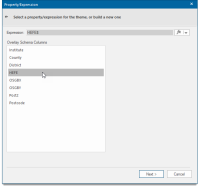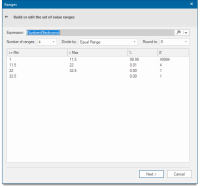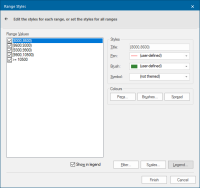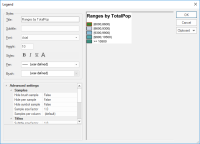Ranges
The Ranges theme takes ranges of values and uses a different pen, brush (and symbol if appropriate) to illustrate each range.
The overall range is calculated from the values of all included items in the overlay.
You can then adjust the number and type of ranges by which the overall range is divided.
Click Home > Add Theme > Style and select Ranges.
Click Next to open the property/expression dialog.
Select the overlay schema column for the theme, in this example HEFE is selected.
Note: Alternatively you can use the fx drop-down button to select either; Pick a Property to select a built-in property or a user defined attribute or Edit an Expression to display the Expression Builder dialog. See also Pick a Property or Edit an Expression.
Click Next.
The Do you want to search the Overlay for existing values? query will be displayed

- If you check the Scan all available items, without prompting tickbox you will not be asked again during the current session.
- If you are repeating the process you will be asked Do you want to clear the Theme and search the Overlay for existing values? again you can set to scan all available items, without prompting.
Click Yes.
The Ranges dialog will show the value ranges.
| Option | Description | |
|
Expression |
shows the selected overlay schema column. |
|
|
Number of ranges |
sets the number of ranges in the Theme. Possible values here are 2 to 100. |
|
|
Divide by |
Equal Range - makes each range equal. Equal Count - makes each range contain, as close as possible, the same number of items. Standard Deviation - spreads the data about the mean value. Fractional values (1/2, 1/3 and 1/4) of Standard Deviation are also available from the drop-down list. Three variations of natural breaks are also available from the drop-down. Natural Breaks are points that best group similar values and maximize the differences between classes. Fisher-Jenks, Jenks and Jenks-Caspall Natural Breaks are available in Cadcorp SIS Desktop |
|
|
Round to |
the range limits can be rounded to a power of 10 in the range 0.01 to 1e+007 or none. |
|
|
>=Min, < Max |
To edit the minimum and maximum values, single click on the minimum number (or press F2) and enter your value. This will change the maximum value for the previous value pair. If you alter the number of ranges after this change, they will be reset and you may have to edit them again. |
|
|
%, # |
The percentage and number of items in each range. |
|
Click Next.
The Range Styles dialog will be displayed:
The Ranges theme assigns different styles (Pen, Brush and Symbol) to every different range it finds. SIS Desktop uses certain default styles but these can be edited for each individual value.
Pens, Brushes and Spread buttons
Click the Pens or Brushes button to display the Pick Colours dialog:
This allows you to apply a meaningful colour scheme to the Pens and/or Brushes used in the theme.
TIP: See also ColorBrewer.
The Spread button becomes active when two or more ranges are highlighted in the Range Values pane.
- To use graduated colour across several ranges, select the first range pair and assign a brush and pen.
- Now select the last range pair and assign a brush and pen.
- Next hold the Shift key down and select all the range pairs.
- Click on Spread.
Check the Show in legend tickbox for each range value that you want to be displayed in the Legend. For example if all values have been selected the theme legend would be:
In this example the SWD would be shown as below:
Click Next to open Range Styles settings.
Filter, Scale and Legend buttons
Click here for Ranges Theme properties.







